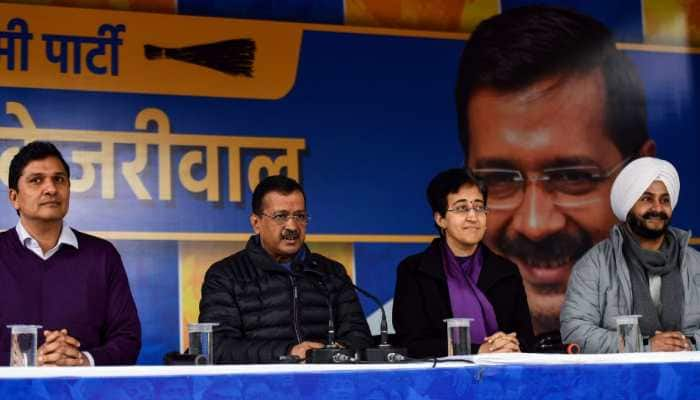Road safety: Delhi govt launches 'Tactical Urbanism Trial' to stop accidents on Signature Bridge
To curb accidents, and make Delhi roads safer, the Delhi government launched 'Tactical Urbanism Trial' on Signature bridge connecting THESE areas, reports PTI.
- Delhi govt launches 'Tactical Urbanism Trial' to reduce accidents on Signature Bridge
- The Signature bridge has witnessed 53 road crashes and 17 fatalities between 2018-2021
- It is the fifth Tactical Urbanism trial in Delhi
Trending Photos
) Image Source: Twitter
Image Source: Twitter Road accidents have been on a constant rise since forever. The government is doing everything in its power to reduce road accidents, from making strict rules for wearing rear seat belts to imposing heavy challans on overspeeding, honking, modified cars, and number plates, traffic police have been taking all preventive measures to reduce accidents. Hence, taking another step ahead to promote road safety and save lives, the Dialogue and Development Commission (DDC) of Delhi launched a month-long ‘Tactical Urbanism Trial’ at the Signature Bridge, connecting Wazirabad across the Yamuna to East Delhi, under the aegis of its' Delhi@2047 'initiative. The Signature bridge has witnessed 53 road crashes and 17 fatalities between 2018-2021, an official statement read.
DDC has been working to reduce all preventable road crash fatalities and injuries at the selected high-fatality intersections in Delhi by facilitating their adoption of tactical urbanism trials. The move will be executed by the DDC in partnership with traffic police and NGO SaveLife Foundation. It is the fifth Tactical Urbanism trial in Delhi, with the four previous ones conducted at Bhalswa Chowk, Rajghat Intersection, Gandhi Vihar, and Burari Chowk.
Tactical Urbanism (TU) trials are temporary, quick, and relatively low-cost interventions, which test out urban design, transportation planning, and infrastructural changes for improving road safety for all road users, especially the most vulnerable, like pedestrians, cyclists, and other non-motorised transport users. According to the statement, structural changes undertaken through redesigning under the project have already led to an 83 percent increase in the availability of safe pedestrian zones and public realms at and around the Signature Bridge.
India's first-ever #TacticalUrbanism trial on an Indian bridge was launched by DDC, BYPL & @savelifeindia today
The month-long trial will test several innovative, low-cost measures to reduce all preventable road crash fatalities & injuries on the Signature Bridge #Delhi2047 pic.twitter.com/pQT9twNI18— Dialogue & Development Commission of Delhi (@DDC_Delhi) October 14, 2022
DDC Vice Chairman Jasmine Shah said the trials so far have proven that such low-cost solutions can have a significant impact by reducing the number of road crash fatalities on target sites and stretches to zero.
He said that the impact of reducing conflict points on the bridge, being undertaken by narrowing merging and diverging angles and approach lanes, will be quantified after the trial concludes on November 6, 2022.
“Signature Bridge is an architectural landmark in India, it should also become a benchmark for road safety across India. Unfortunately, 53 road crashes and 17 fatalities have taken place here over the last four years," Shah said in the statement.
The 'Tactical Urbanism' approach especially focuses on safeguarding the most vulnerable road users like pedestrians, cyclists, and other two-wheeler riders, he said. “By testing out and scaling up effective urban design, transportation planning, and infrastructural changes, such as this under the 'Dehi@2047' initiative, we will be enhancing road safety for all road users,” Shah said.
DCP, Traffic (North and Central District), Chandra Kumar Singh said that reduction of speed through the additional speed calming measures put in place during this trial will help reduce over-speeding and make the stretch safer for all road users visiting the Bridge.
CEO, SaveLife Foundation, Piyush Tewari said that under SLF's 'Zero Fatality Corridor' model, data and evidence are used to ascertain the best possible solution for saving lives by minimising road crashes and consequent fatalities.
Tewari said that the Tactical Urbanism trial at the Rajghat intersection reduced pedestrian conflict by 32 percent and vehicular conflict by 81 percent. Similarly, at Bhalswa Chowk, the Tactical Redesigning led to a 50 percent reduction in pedestrian conflict with fast-moving traffic. At Burari Chowk, the intervention resulted in the reduction of pedestrian exposure distance by 51 percent and exposure time by 52 percent, he said.
Based on the findings of these trials, permanent interventions have been suggested to the civic agencies. BSES Yamuna Power Limited, Delhi Transport Department, and road-owning agencies including PWD (Central and Northeast) and Delhi Tourism and Transportation Development Corporation (DTTDC) are also working in close partnership for carrying out these trials. Under the initiative, low-cost measures have been adopted at the bridge temporarily to measure their impact on the following issues identified as possible causes of accidents there.
Nine sets of transverse bar markings (TBMs) have been used along the main carriageway of the bridge as speed-calming measures. Measures such as extended diverging and merging edges through temporary measures such as spring posts, road geometry correction, and reduction of diverging and merging angles are being taken under the initiative.
Installation of signages like hazard markers, directional signages, informational signages, under-surveillance signages, and those prohibiting wrong-side movement will also be installed in the campaign, the statement said. Inaugurated in November 2018, Delhi's Signature Bridge cantilever spar cable-stayed bridge is India's first asymmetrical cable-stayed bridge.
Launched as both a tourist attraction and a means of reducing travel time for commuters plying between north and northeast Delhi, the Signature Bridge connects Wazirabad across the Yamuna to the inner city.
(With inputs from PTI)
Stay informed on all the latest news, real-time breaking news updates, and follow all the important headlines in india news and world News on Zee News.
Live Tv







)
)
)
)
)
)
)
)
)
)
